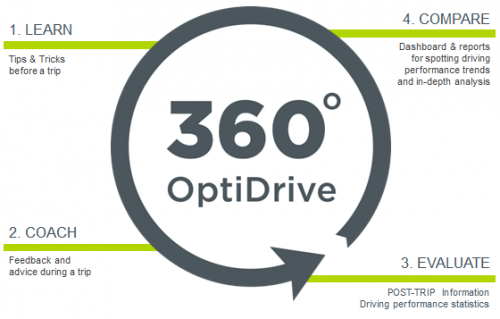Companies with fleets of all sizes have had to deal with fuel wastage for decades to try to keep a handle on fuel costs. But what can you do right now to help lower your fuel costs?
Today, there are a many things you can do to reduce costs, and there are many tools available to managers and drivers that help control fuel costs. Let’s review some of the key areas to focus on to help you run a safe and efficient fleet:
Driver Behavior
Do you have an issue with poor driver behavior in your business? Unnecessary idling significantly pushes up fuel costs. Idling gets zero miles per gallon, and every two minutes uses the same amount of fuel it takes to drive one mile! That’s a huge waste which is coming off your bottom line. Aggressive driving not only wastes fuel from over revving and speeding, but also means higher maintenance costs. Tackling both of these areas and encouraging responsible driving helps you to lower fuel usage, maintenance and insurance premiums, reducing the total costs of vehicle ownership, as well as maintaining your reputation while on the road.
While rewarding or reprimanding driving style doesn’t consistently achieve optimal results, a system that provides active driver feedback focuses on engagement to change this behavior for the long term. A great example is OptiDrive 360, a complete approach to help drivers adapt a responsible driving style by providing valuable insights to both the fleet manager and the driver – delivering direct feedback to drivers before, during and after their trip. Optidrive operates using the following 4 principles:

Fuel Card Integration
The use of corporate fuel cards to manage fuel purchases has gained significant traction over the past decade. Customers quickly find that a fuel card account is accompanied by data and reports, lots of reports. However, without the full context of whom, when and where purchases were made, these reports are difficult to extract value from.
By combining telematics data (vehicle location, odometer, assigned driver and time) with detailed fuel card transaction activity (location, time, fuel type, cost, volume, etc.), these reports empower companies to increase visibility of transactions and enables better control of spending. It also helps to provide greater scrutiny on every purchase to identify unauthorized, inefficient and potentially fraudulent purchases.
Get insights on:
- When and where the vehicle’s fuel card was used
- Cost on fuel purchases of single vehicles and your entire fleet
- Amount of refueled gallons and fuel type
- Indications of potential fuel card misusage
Navigation/Traffic Avoidance

How many times have you received calls from customers looking for your techs? How many times have they missed a service time slot? Professional navigation with traffic-based routing enables employees to drive fewer miles and get to their destination using the quickest routes based on the time of day, so when there is an accident or some other reason for congestion, your drivers are able to avoid the affected roads and find the next best route. Fewer miles, with less downtime in traffic, results in fuel savings.
Route Planning
Do your employees take vehicles home? Do they go to their favorite restaurant for lunch that’s completely out of the way? Unsanctioned route deviations, afterhours or off-day usage can occur if you’re not monitoring your fleet 24/7. Route planning allows you to reduce miles driven, resulting in fuel savings.
Imagine being able to make more deliveries every day with the same amount of resources. Replacing manual processes with an automated route planning system can intelligently balance and optimize your daily routes with the click of a button.
Learn more about route planning in our whitepaper Reduce miles driven up to 30% with more optimal and accurate routes or through an integration partner on our app center for MyRouteOnline.
Vehicle Maintenance

Regular maintenance as recommended by the vehicle owner’s manual will help your vehicles achieve their best fuel economy.
If currently managing vehicle maintenance manually, consider adopting an automated process to help avoid missing needed repairs and utilizing live data to effectively schedule the maintenance. Keep in mind, the harder the vehicle is being driven; the more service & maintenance will be needed. It is very difficult to track this manually, making more important to use that data to save maintenance and fuel costs.
For more information on vehicle maintenance methods, refer to our guest blog post by our partner Fleetio, How to Forecast Vehicle Maintenance Using Telematics Data.
Telematics Systems
Real-time vehicle location with accurate ETA calculations ensures better dispatching decisions. By selecting the best operator for the closest job makes the fleet more efficient individually and as a whole. Telematics systems today can range from the basic GPS tracking to a complete in-vehicle management solution.
Lowering fuel costs is one of the more obvious reasons business owners invest in a fleet management solution. Since the selection of solutions is more complex than ever, check out our post on Picking the Right Telematics Systems
Find out more ways of how to save fuel in your fleet in our free guide 3 Fuel Saving Strategies for your Business.








